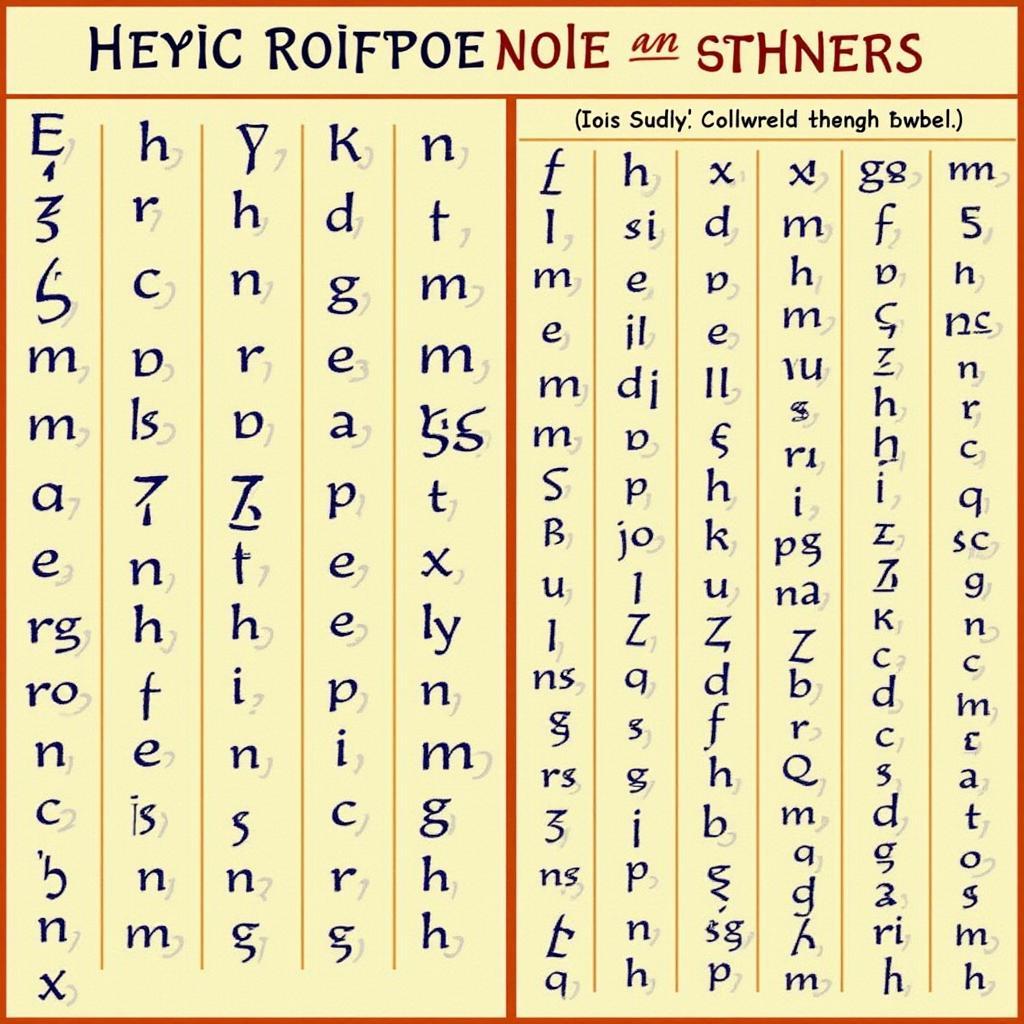Unraveling the Mysteries of Ancient African Hieroglyphic Symbols
Hieroglyphics, the ancient Egyptian writing system, immediately conjures images of pyramids, pharaohs, and intricate symbols etched onto temple walls. But did you know that the use of hieroglyphic symbols extends far beyond the borders of ancient Egypt, reaching deep into the heart of Africa? This article delves into the fascinating world of African Hieroglyphics Symbols, exploring their origins, meanings, and cultural significance.
More Than Just Pictures: Deciphering African Hieroglyphics
Often misunderstood as mere pictures, African hieroglyphics are far more complex. They represent a sophisticated writing system where symbols, known as glyphs, can represent:
- Ideograms: A single glyph conveying a whole word or concept. For example, a picture of a sun might represent the words “sun,” “light,” or “day.”
- Phonograms: Glyphs representing sounds, similar to letters in the English alphabet.
- Determinatives: Symbols used to clarify the meaning of a word or phrase, often placed at the end.
 African Hieroglyphic Alphabet Chart
African Hieroglyphic Alphabet Chart
A Journey Through Time and Cultures: The Origins of African Hieroglyphics
While the ancient Egyptians are credited with perfecting the hieroglyphic system, evidence suggests its roots might lie deeper in Africa. Discoveries of ancient rock art across the continent, some dating back thousands of years, bear striking similarities to Egyptian hieroglyphs. These findings suggest a possible shared origin or at least a cultural exchange that influenced the development of writing systems in different African civilizations.
Beyond Ancient Egypt: Exploring Hieroglyphics in Other African Cultures
The influence of hieroglyphics is evident in other African cultures as well. For instance, the ancient Nubian civilization, located in present-day Sudan, developed its own unique script known as Meroitic. This writing system, while inspired by Egyptian hieroglyphs, incorporated distinct characters and grammatical structures, reflecting the Nubians’ own cultural identity.
Further south, archaeological sites in West Africa have yielded artifacts adorned with symbols reminiscent of hieroglyphs. While the exact nature and meaning of these symbols are still being studied, their presence hints at a possible widespread use of hieroglyphic-like scripts across the African continent. You can learn more about these fascinating discoveries on our African artifacts history page.
Unlocking Cultural Secrets: The Significance of African Hieroglyphics
African hieroglyphics offer invaluable insights into the beliefs, values, and daily lives of ancient African civilizations. By deciphering these symbols, we gain a deeper understanding of:
- Religious Beliefs: Many hieroglyphs depict deities, mythical creatures, and religious rituals, providing glimpses into ancient African cosmologies and spiritual practices. The African ankh, a symbol of life, is a prime example of how hieroglyphs offer insights into religious beliefs.
- Social Structures: Hieroglyphic inscriptions often mention rulers, officials, and common people, shedding light on the social hierarchies and power dynamics of ancient African societies.
- Daily Life: From depictions of agricultural practices to scenes of musicians and dancers, hieroglyphs offer a window into the everyday activities and cultural practices of people who lived centuries ago.
The Legacy of African Hieroglyphics
The study of African hieroglyphics is an ongoing journey of discovery, with each new inscription deciphered adding to our understanding of Africa’s rich history and cultural heritage. These symbols are not merely relics of the past but a testament to the intellectual and artistic achievements of ancient African civilizations, urging us to appreciate the complexity and diversity of Africa’s past and present. For a deeper dive into the artistic expressions of these civilizations, explore our pages on African Egyptian art and African art and architecture.
African Hieroglyphics: Frequently Asked Questions
1. Were all African hieroglyphics the same?
While many African cultures utilized hieroglyph-like symbols, each civilization developed its own unique script with distinct characters and grammatical rules.
2. Can anyone read African hieroglyphics?
Deciphering African hieroglyphics requires specialized knowledge and training. Epigraphers, scholars who specialize in ancient writing systems, dedicate years to learning the intricacies of these scripts.
3. What are some of the challenges in studying African hieroglyphics?
Limited access to archaeological sites, the effects of weathering and erosion on inscriptions, and the loss of cultural context pose significant challenges to researchers.
4. Why is it important to study African hieroglyphics?
Understanding African hieroglyphics helps us reconstruct the history, beliefs, and cultural practices of ancient African civilizations, providing valuable insights into their contributions to human civilization.
5. Where can I learn more about African hieroglyphics?
Museums, universities, and online resources dedicated to African history and archaeology offer valuable information and research on African writing systems.
Unraveling the Past, Illuminating the Present
African hieroglyphic symbols, with their enduring presence across the continent, offer a captivating glimpse into the ingenuity and cultural richness of Africa’s past. By studying these symbols, we embark on a journey of discovery, uncovering hidden stories, and gaining a deeper appreciation for the diverse tapestry of African cultures that have shaped our world.
Need assistance? Contact us at +255768904061, [email protected], or visit us in Mbarali DC Mawindi, Kangaga, Tanzania. Our customer service team is available 24/7.
